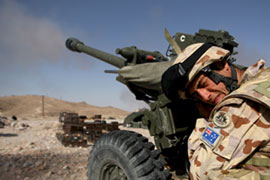Australia plans military build-up
Naval and air fleet to be modernised in attempt to keep pace with Asian nations.

China factor
A long-term strategic blueprint for the future of Australia’s armed forces, Force 2030 cautions that war could be possible in the Asia-Pacific region in the next two decades, as emerging powers such as China boost military spending.
“China will be the strongest Asian military power, by a considerable margin,” it says.
“A major power of China’s stature can be expected to develop a globally significant military capability befitting its size.”
Wen Jiabao, China’s premier, said in March that the country’s military would be extensively modernised.
He asked legislators for a 15.3 per cent increase in defence spending for 2009, taking it to $69bn for the year – double the funding levels for 2006.
Cause for concern
The Australian strategic document says that “the pace, scope and structure of China’s military modernisation have the potential to give its neighbours cause for concern if not carefully explained, and if China does not reach out to others to build confidence regarding its military plans”.
It also describes the US as an “indispensable” ally for Australia.
Analysts say that the apparent criticism of China and Australia’s alignment with the US will probably meet with anger in Beijing.
“China definitely will not accept Australia adopting the so-called China threat thesis,” Shi Yinhong, a professor at Beijing’s People’s University, told the Sydney Morning Herald newspaper on Friday.
“[China] will have to publicly criticise [the paper].”
‘Serious challenge’
The Australian document says that a major conflict on the Korean peninsula remains a possibility and the collapse of North Korea cannot be ruled out, while Myanmar remains a “serious challenge”.
 |
| Australia is the largest non-Nato contributor to the international force in Afghanistan [EPA] |
There are also warnings that world powers will be jockeying for naval supremacy in the Indian Ocean as it gains importance as a seaway for oil shipped from the Middle East to Asia.
Australia’s current fleet of six Collins-class submarines will be replaced by 12 longer-range Australian-manufactured submarines.
But the government, which bans atomic energy in Australia, has ruled out nuclear propulsion.
The navy’s 12 frigates will be replaced by the same number of larger warships and there are plans to buy 100 US-manufactured Lockheed F-35 Lightning Joint Strike Fighters, while the current Boeing F/A-18 Super Hornets are phased out.
Australia is the largest contributor to the US-led force in Afghanistan from outside of the Nato military alliance.
Rudd announced this week that the Australian military commitment there would be boosted from 1,100 to 1,550 soldiers.